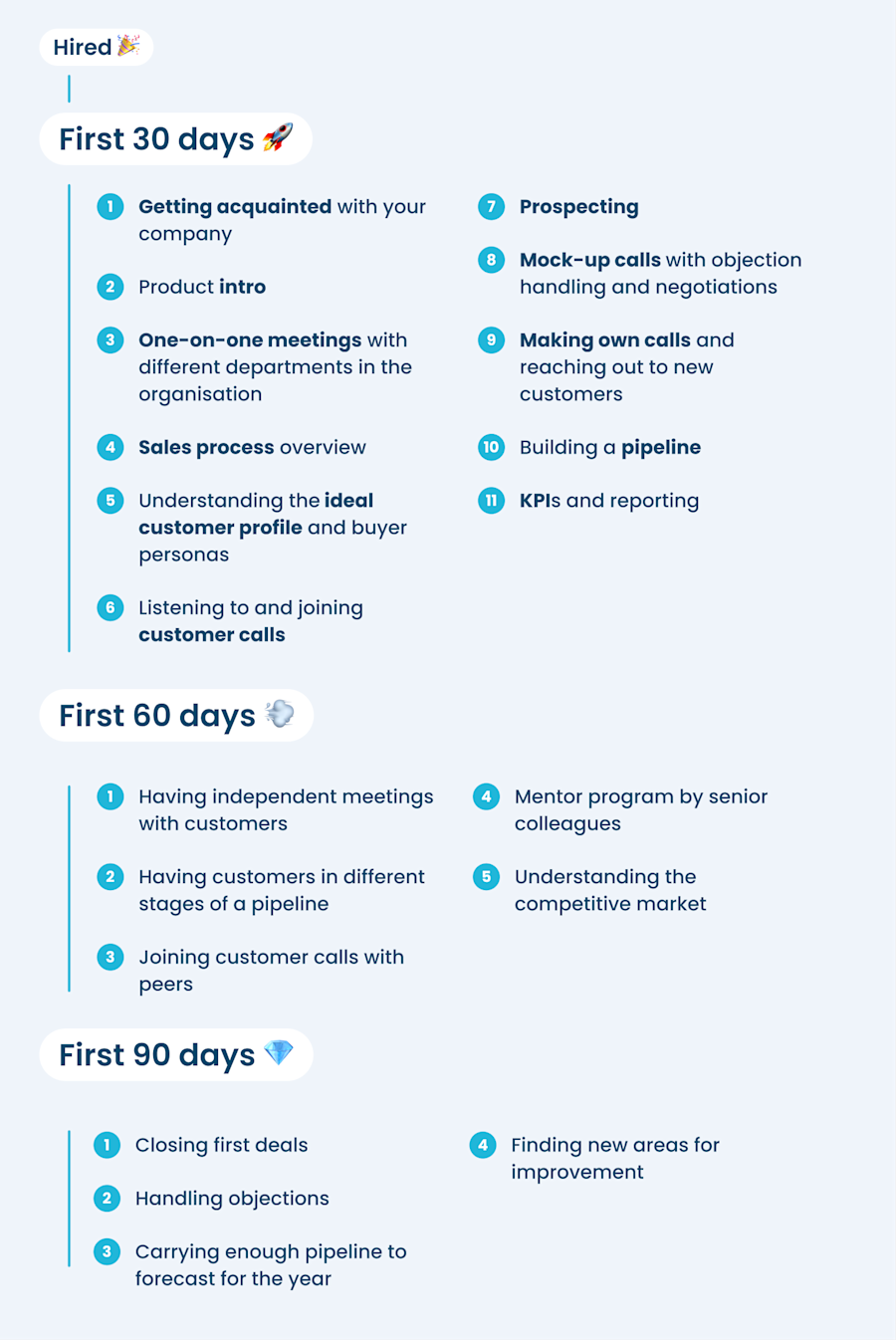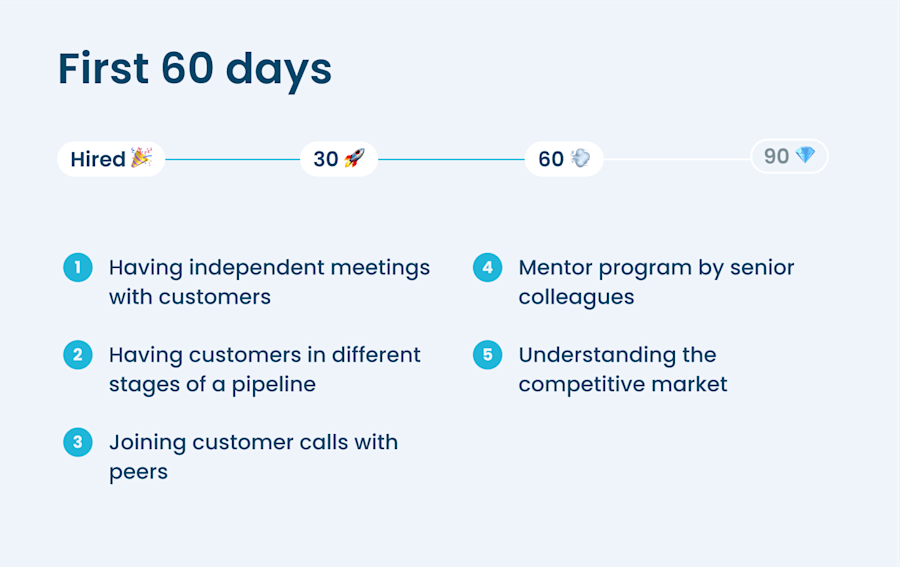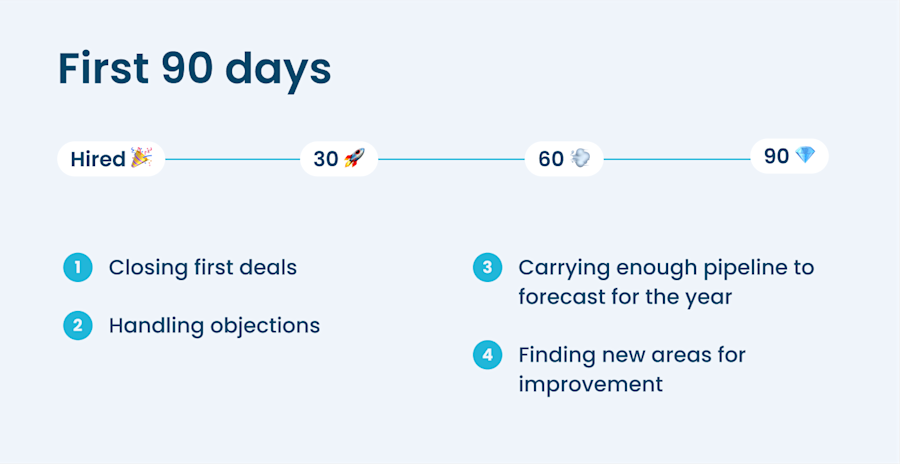First impressions are everything, especially when it comes to starting a new job.
Good hiring managers will all tell you that the onboarding process matters. It can literally make or break a new hire’s experience with the company. So how can you ensure you get it right and your new employees achieve their work and personal goals in the all-important first three months?
A 30-60-90 plan is the answer. This document gives new employees a clear roadmap showing what they should focus on during their first 90 days at work. It also helps managers track new hires' progress and check that they’re equipped to handle their new responsibilities.
In this blog post, I wanted to look at what goes into a 30-60-90 plan for an account executive and how the action plan supports your company's culture and goals. Even better, I’ll describe a 30-60-90 plan template that you can use right away to onboard your new AE.
Sounds good?
What is a 30-60-90 plan?
A 30-60-90 day plan is a document that lists the specific tasks and performance goals new hires need to achieve in the first 90 days at a new job. Simply put, it’s a tool that allows them to communicate their goals while aligning them with company strategies.
Employees often create the plan during the first weeks, with a supervisor guiding them. New hires can then update the goals and tasks as they get more familiar with your company's culture and activities.
When is a plan like this used in a sales team?
Sales managers typically use a 30-60-90 plan when onboarding new account executives. The plan can also help if you’re onboarding SDRs and BDRs who’ve been promoted to account executives.
Now let's look at the benefits of a 30-60-90 for both new hires and their managers in more detail.
Why do you need a 30-60-90 plan for an account executive?
Your account executives are key to retaining your existing customers and closing more deals. A bad or piecemeal executive onboarding process easily leads to poor sales performance — and, ultimately, high turnover.
A 30-60-90 plan gives your new executive the best chance of success in their new role and will hopefully set you both up for a positive, long-term working relationship. Here's how it works.

A 30-60-90 plan helps to introduce new hires to your company's culture. Typically, you’ll communicate the values and top priorities of both your company and your customers.
The plan may also include meetings with other team members, departments, sales reps, mentors, and buddies. This shows newcomers your company's interest in their growth and stops your new hire from feeling lost or that they’re drowning in a sea of tasks (and eventually, burning out).
Practically speaking, a 30-60-90 plan outlines a clear course of action with specific tasks and deadlines for a new hire to meet. This gives your executive a sense of purpose and helps mentors keep them on track as they’re learning. Both mentors and the plan should encourage your hire to take initiative in decision-making so they’re less likely to distract managers or other stakeholders from their work.
If this onboarding model sounds attractive to you, keep reading.
A typical 30-60-90-day plan template for account executives
Our 30-60-90 plan template is a great way to introduce your company culture and workflow to new account executives.

This 30-60-90 plan example covers the following aspects of the ramp-up period:
Company overview: An introduction to your company, its history, mission, vision, values, and corporate culture.
Sales skills: Evaluating current soft and hard skills and setting goals for skills development.
Industry knowledge: Assessing your new hire's understanding of the industry and market trends, your main competitors, and sales and marketing strategies. Establishing goals for closing gaps.
Product or service knowledge: Presenting the specifics of your company’s products or services.
Customer insight: Familiarize your hire with your target market, trends, customers, and their behavior. Developing strategies to tailor account executives’ performance to their needs.
Company sales processes and tools: Immersion in your company's sales processes and tools.
The actual details of your plan will depend on your company and the role of your account executive. Still, let’s look at some typical template elements.
Elements of a development plan
A 30-60-90 plan is like a mini development plan for your new hire. And just like any development plan, it should have a mission or purpose, attainable goals, and resources.
The primary role of your account manager is to build and maintain relationships with customers, meet or exceed sales figures, and capitalize on new business opportunities.
You can break this role down into incremental learning goals using the S.M.A.R.T. framework. Within this framework, the best goals have five qualities:
Specific goals: Good goals are unambiguous and target a specific area. Account executives might have a specific goal of scheduling client meetings each week to check in on their needs and address any concerns.
Measurable goals: The goal should be quantified so that progress can be tracked and evaluated. For example, how many weekly client appointments will the executive need to have?
Achievable goals: A goal should be realistic in the sense that it can be accomplished with available resources and within existing constraints. For example, to schedule meetings with clients in Google Meet and send reminders on LinkedIn.
Relevant goals: A goal should align with your organization's mission and with the employee's job duties and personal objectives. Meeting with customers regularly, for example, helps a business maintain strong relationships. Additionally, regular meetings help account executives deal with objections effectively.
Time-bound goals: Time-bound goals have a specific deadline or timeframe for completion.
Setting smart goals ensures that your new executive is working on something that matters and keeps them accountable for their actions.
Alongside goals, resources are key to the success of your plan. These could include books, courses, workshops, mentoring, coaching, and, most importantly, talent. A sales manager should never forget that it is people who set goals, take action, and make changes for the good of the company.
The following steps will help ensure your new hires fulfill their potential and make a positive impact on your company.
First 30 days of the plan
A new employee's first month is crucial to learning the ropes and adjusting to your company culture. In this stage, your account executive will learn their role, responsibilities, and expectations, start building relationships with their colleagues and supervisors and lay the groundwork for the next 60 days.

Here are some examples of goals in the first 30 days of a 30-60-90 plan.
1. Getting acquainted with your company
Making a positive first impression on a new employee begins here. It's simple enough: start with your company’s mission, history, and values that guide everything you do — from the projects you work on to how you treat each other.
2. Product intro
Explain how your company's products solve customer problems, with key features and benefits. When an account executive truly believes in the benefits of your company's offerings, their enthusiasm and passion will spread.
You should also communicate where a product falls shorthand exceeds the competition. That way in meetings, they’ll be prepared when hit with hard questions.
3. One-on-one meetings with different departments in the organization
Visiting different departments will help a new hire better understand your company's internal operations. Relationships with other team members will be key to supporting future negotiations, and when employees feel valued as part of a bigger whole, they’re more motivated and engaged.
4. Sales process overview
Now is the time to show your account executive the battlefield. Describe how your company engages customers and closes deals and what the AE role is at every step in the process.
Explain the sales process using real-life examples and case studies. This can help clarify the process and make it easier to follow.
5. Understanding the ideal customer profile and buyer personas
Describe the ideal customer profile for your company, including industry, size, location, and budget. Don’t forget to add how this profile fits into your overall sales strategy.
Give an overview of the needs, problems, and buying motivations for each customer persona. Provide examples of how each persona might contact the company and what the sales process would look like in each case.
6. Listening to and joining customer calls
Take it slowly, so your newbie doesn’t get swept away in a tide of challenges too soon. Listening to customer calls is a small rehearsal before the big swim. Experienced colleagues can serve as role models for new account executives, providing tips and best practices for dealing with customers.
7. Prospecting
During this phase, your account executive will make their own efforts to find potential clients. Encourage them to think outside the box and develop messages that resonate with your target market.
Share your prospecting successes (and failures) to show how persistence and creativity can lead to successful acquisitions.
Don't forget to equip your hire with comprehensive lead generation tools and CRM integration. These are key to a successful sales enablement process and will make for an easier, more enjoyable journey to new customers, based on data-driven insights.
8. Mock-up calls with objection handling and negotiations
Consider setting up mock-up calls in a controlled environment, such as a training session, with a role player or coach acting as the customer. Done right, realistic mock-ups will prepare your executive to deal with objections and make effective sales presentations in real-world situations.
9. Making own calls and reaching out to new customers
Encourage your account executive to remain authentic and provide them with all the materials and resources they’ll need to meet the customer on their own ground.
One deep breath, and your newbie will be calling their first account client for you.
10. Building a pipeline
With some practice in hand, you and your new hire can move on to strategic planning. Account executives must handle the entire customer journey, from qualifying to nurturing potential customers.
Each step involves a specific set of actions, including resources. Demos and trials, for instance, are helpful in the nurturing phase. Give your newbie everything they need to survive and thrive as they develop their sales pipeline.
11. KPIs and reporting
The first 30 days were a wild ride. Your account executive has been hitting the phones and hustling to build their pipeline. Schedule a 1:1 meeting to recap this time and move them to the next level.
In your meeting, evaluate the first 30 days of work and set measurable goals. Create reports on account executive performance based on key sales metrics. To get started with KPIs, you can measure lead response time or the number of calls. If appropriate, you can also look ahead to target conversion rates.
First 60 days of the plan
With 30 days of experience, your account executive should be ready to face real challenges in the brave new sales world. The second month sets the tone for the rest of their time with your company. Below are some steps to help a new employee get off to a good start (and hit the ground running).

1. Having independent meetings with customers
That’s right: your exec should be on their own this time. Loosen the reins and let new employees learn from their mistakes. This is where they’ll learn to find the sweet spot between pushy and passive.
2. Having customers in different stages of a pipeline
Time management and attention to detail are essential here. Juggling multiple priorities, deadlines, and customer needs can be a challenge, especially when your account executive doesn't want to drop any.
3. Joining customer calls with peers
At this level, your new employee will deal with objections from multiple customers. Make sure they can control sales call agendas so they don’t end up discussing the latest football match instead of communicating product benefits.
4. Mentor program by senior colleagues
Now that your new employee has basic knowledge and skills, it's time to grow them. Start by looking at your new employee’s mistakes. Assign a more experienced account executive to teach them the fine skills of active listening, workload balancing, and creative thinking.
5. Understanding the competitive market
Throughout the training, your new hire should always have your competition in mind. They should also use online resources, industry reports, and publications to gather information about the competitive landscape and market trends and examine your competitors' strengths and weaknesses.
We’re almost at the finish line! Let’s see what your account executives should have achieved by the third month.
What you should have accomplished by day 90
The last 30 days of a 30-60-90 plan provide a reference point for evaluating your employee's performance and progress. This is where your new hire will take independent steps in sales for your company.

1. Closing first deals
Your account executive already knows your expectations and the specifics of your customer database. Therefore, they must now have all the necessary tools to impress your target audience, you — and even themselves. They’re the experts here, walking into meetings with their heads held high, and all that's left for you is to be proud.
Your pride doesn’t have to be silent. Don’t forget that you can offer incentives to your account executive, such as bonuses for reaching certain milestones, commission-based payouts, and opportunities for advancement.
2. Handling objections
By day 90, your account executive should be able to handle customer objections like a boss. They should already have mastered active listening, understanding customer concerns, finding common ground, and pinpointing and addressing key customer issues.
3. Carrying enough pipeline to forecast for the year
As your account executive successfully progresses through the first quarter, it’s time to consider the future. By this stage, they should already know every detail of their sales pipeline and be able to identify patterns and trends to build what-if scenarios, experiments, and forecasts.
4. Finding new areas for improvement
Your new hire will already have learned a lot by the end of their 30-60-90 plan. But this is just the beginning. When the first quarter ends, what new heights should they aim for?
Take time to give honest feedback on your new employee's performance. This way, you’ll identify any areas for improvement. Then you can focus on increasing their knowledge of the products and the industry and show them how to better prioritize tasks and optimize collaboration with other teams. You can consolidate the outcomes of your onboarding plan with sales enablement tools and a training program for after the 90-day period.
Conclusion
Continuous improvement is a journey, not a destination. Likewise, your new account executive’s development shouldn’t end with their 30-60-90 plan.
The plan is an exciting starting point, as it gives a clear idea of what new employees need to accomplish and how they’ll get there. Why rush into things? Instead, allow your new employees to take small steps and become true professionals with a well-designed 30-60-90 plan for onboarding.
Now that you're here
Leadfeeder is a tool that shows you companies that visit your website. Leadfeeder generates new leads, offers insight on your customers and can help you increase your marketing ROI.
If you liked this blog post, you'll probably love Leadfeeder, too.
Sign up







